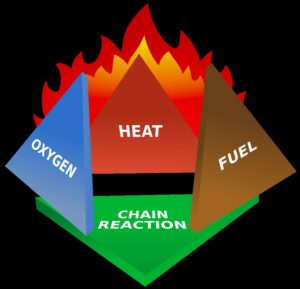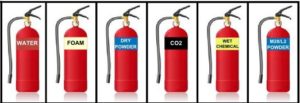FIRE EXTINGUISHER TRAINING
South Pigeon Lake Fire Department
UNDERSTANDING FIRE
- To learn how to extinguish fire, we must first learn how fire works.
- To learn how fire works, we must first examine what types of fires we may have, then we can learn how it works.
- What kinds or types of fires may we have in this work place?
- What kinds or types may we have at home?
Fire Tetrahedron

Classes of Fires
- CLASS A FIRES
- Wood, paper, organic substances.
- CLASS B FIRES
- Flammable Liquids. Gasoline, Paint, Solvents, Diesel Fuel, Cleaning Agents, Propane etc.
- CLASS C FIRES
- Electrical Fires. Electrical panels, electric motors, transformers, power lines.
- CLASS D FIRES
- Combustible metals. Lithium, Magnesium.
- CLASS K FIRES
- Cooking oils, Animal Fats, Vegetable oils.
TYPES of FIRE EXTINGUISHERS
- WATER and FOAM
- Used for Class A fires ONLY !!!
- Water removes the Heat element, Foam removes the Oxygen element.
- DRY CHEMICAL
- Commonly used for ABC fires.
- Separates oxygen from the fuel.
- CARBON DIOXIDE
- Used for B and C Fires. Removes the Oxygen element.
- CLEAN AGENT
- Designed for class B and C fires, but can be used on A class.
- Halon interrupts the chemical reaction part of the fire tetrahedron.
- DRY POWDER
- Used on Class D fires. Separates the fuel from the Heat, and eliminates the Oxygen.
- WET CHEMICAL
- Used for class K fires. Turns the burning cooking oil and grease into a soap, and eliminates the heat part of the tetrahedron. Putting a lid on a grease fire in a pan, is very effective.
Lets Watch This Video
WHAT I SHOULD DO IF I HAVE A FIRE
- Is the Fire too big, or can I put it out ? If unsure, alert others, exit the building, and and call 911. KNOW YOUR ADDRESS.
- If you decide to attack it, assure you can handle the smoke and fumes.
- Plan an escape route, and NEVER turn your back on the fire.
- Use the P.A.S.S method with your extinguisher.
PULL the PIN.
AIM at the base of the fire. NOT the flames.
SQUEEZE the handle to activate the extinguisher.
SWEEP across the base. Back and forth in a sweeping motion.
5. Assure the fire is completely out, and ventilate the building,
6. Determine the cause and work to prevent it from happening again
